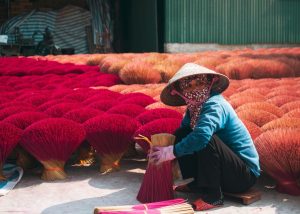Traditional Dye Making: Natural Color Arts
In today’s fast-paced and technologically advanced world, the use of chemical dyes has become the norm for coloring fabrics and other materials. However, there is still an intricate and fascinating art of traditional dye making that involves the use of natural ingredients to create vibrant and long-lasting colors. This age-old technique not only produces stunning hues but also has a rich cultural significance. Let’s delve into the world of traditional dye making and discover the beauty and history behind this ancient craft.
What is Traditional Dye Making?
Traditional dye making is a method of coloring fabrics, yarns, and other materials using natural ingredients such as plants, minerals, and even insects. This technique has been used for centuries by different cultures around the world to create colors that are unique to their region and traditions. From the rich and vibrant hues of India to the earthy tones of Africa, traditional dye making has played a significant role in cultural identity and expression.
The Process of Traditional Dye Making
The process of traditional dye making involves several steps, from harvesting the natural ingredients to preparing the dye and finally, colorizing the material. The first step is sourcing the natural materials, which are then cleaned and sorted before being crushed or boiled to extract the color. The dye is then mixed with water and a mordant, a substance that helps the dye bond to the fabric. Common mordants include vinegar, alum, and iron. The material is then soaked in the dye solution, and depending on the desired color intensity, the process may be repeated several times. The final step involves rinsing and drying the material, resulting in a uniquely vibrant and lasting color.
The Importance of Traditional Dye Making
The ancient art of traditional dye making holds significant cultural and historical importance. In many cultures, colors and dye-making techniques are passed down through generations, preserving their heritage and identity. For example, the vivid colors used in traditional Indian clothing, such as the bright red of the bride’s sari, are a symbol of happiness and prosperity. The use of natural dyes also has a positive impact on the environment, as it is a sustainable and eco-friendly alternative to chemical dyes.
The Beauty of Natural Colors
The beauty of traditional dye making lies in the vibrant, natural colors it produces. Unlike synthetic dyes, which can fade quickly, natural dyes often become richer and more beautiful with time. Each natural ingredient carries its distinct color, allowing for a vast range of hues and shades to be created. The colors produced are also unique, as they are affected by factors such as the climate, soil, and time of harvesting. This adds to the charm of traditional dye making, making each piece of fabric or yarn truly one-of-a-kind.
Preserving Traditional Dye Making
As the world becomes more modernized and industrialized, the art of traditional dye making is at risk of dying out. However, there has been a recent resurgence in the popularity of natural dyes, with more and more people seeking sustainable and eco-friendly options. There are also organizations and communities dedicated to preserving this ancient art by educating and training future generations. By supporting and promoting traditional dye making, we can ensure that this valuable and beautiful art form continues to thrive.
In Conclusion
The traditional dye-making process may be time-consuming and require intricate knowledge and skills, but the results are undoubtedly worth it. From the beauty of natural colors to the cultural importance and environmental benefits, traditional dye making is a truly remarkable craft. So the next time you wear a vibrant, natural-colored garment, remember the fascinating world and history behind it. With a little appreciation and support, we can keep the tradition of natural color arts alive for many years to come.









